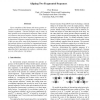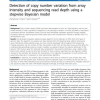1517 search results - page 58 / 304 » Human Genome Annotation |
JSAI
2001
Springer
14 years 2 months ago
2001
Springer
Discovering new topics which cover new items, problems, and ideas (e.g., mobile phone, global warming, human genome project, etc) is truly profitable, important, and interesting f...
IPPS
2002
IEEE
14 years 2 months ago
2002
IEEE
Upon completion of the human and mouse genome sequences, world-wide sequencing capacity will turn to other complex organisms. Current strategies call for many of these genomes to ...
BMCBI
2010
13 years 10 months ago
2010
Background: Copy number variants (CNVs) have been demonstrated to occur at a high frequency and are now widely believed to make a significant contribution to the phenotypic variat...
EMNLP
2008
13 years 11 months ago
2008
A human annotator can provide hints to a machine learner by highlighting contextual "rationales" for each of his or her annotations (Zaidan et al., 2007). How can one ex...
BMCBI
2010
13 years 10 months ago
2010
Background: Phosphorylation events direct the flow of signals and metabolites along cellular protein networks. Current annotations of kinase-substrate binding events are far from ...


